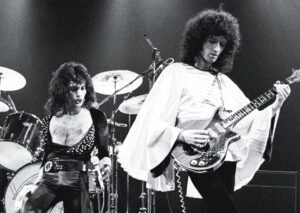How to Play Bohemian Rhapsody.
A Revolutionary Song Broken into 6 sections
Bohemian Rhapsody by Queen is one of the most iconic rock songs of all time, featuring a unique structure, complex harmonies, and genre-defying sections. In this comprehensive chord analysis, we’ll break down each section of the song, focusing on the chord progressions, key changes, and harmonic intricacies.
Whether you’re learning how to play Bohemian Rhapsody chords or looking for a detailed Bohemian Rhapsody chord analysis, this guide will help you dive deep into Freddie Mercury’s masterpiece. And don’t forget to check out the video walkthrough by Tom Donald at the end!
Introduction: Setting the Key (Bb Major)
The introduction of Bohemian Rhapsody begins with a haunting, a cappella vocal line in the key of Bb major. While there are no instrumental chords, this section sets the tone for the piece.
Bb6 C7 Bb6 C7 Is this real life, Is this just fantasy? F7 Cm7 F7 Bb Cm7 Bb Caught in a landslide, no escape from reality.
Verse 1: The Ballad Section (Bb and Eb Major)
After the introduction, the piano enters, playing a ballad in Bb major. This section is reflective and melancholic, leading into a beautiful chord progression that modulates to Eb major.
Gm Open your eyes Bb7 Eb Ab Eb Look up to the skies and see Cm Cm7 Cm F7 I'm just a poor boy, I need no sympathy
The iconic line “easy come, easy go” features chromatic movement between the chords, a signature technique used throughout the song:
B Bb A Bb B Bb A Bb easy come, easy go, little high, little low
Chorus: The Emotional Peak (Eb Major)
In the chorus, the song modulates to Eb major, and we see a familiar ii–V–I progression, along with passing diminished chords that add depth to the harmony:
Eb Bb/D Cm Fm C/E Ab/Eb Ddim Bb Mama Ooooo____ didn't mean to make you cry
Verse 2: The Story Continues (Bb Major)
The second verse follows the same structure as the first, returning to the key of Bb major, but with more intensity in the lyrics:
Bb Gm Too late, my time has come Cm Cm7 F7 Sent shivers down my spine, body's achin' all the time
Guitar Solo: Following the Ballad (Eb Major)
The guitar solo section follows the ballad structure and stays rooted in Eb major, with some passing diminished chords that lead into the next dramatic shift.
Eb Bb/D Cm Fm C/E Ab/Eb Ddim Bb Bb Bb6 Bb7
One of the most interesting chord progressions appears at the end of the guitar solo with a chromatic descent: **Db, Db/C, Db/B, Bbm**. This progression creates a dystopian, theatrical feeling, while at the same time, it doesn’t take itself too seriously—perfectly in line with the operatic and playful nature of the song.
Opera Section: Dramatic Modulation (A and Eb Major)
The opera section is where the song truly showcases its theatrical nature, moving between various keys. It begins in A major and modulates freely before settling back into Eb major:
A D/A A Adim A D/A A Adim I see a little silhouetto of a man
As the drama unfolds, we see chromatic shifts that add to the operatic intensity:
B Bb A Bb B Bb A Bb I'm just a poor boy, nobody loves me
Interestingly, Queen and Elton John shared the same manager, John Reid. When Elton first heard Bohemian Rhapsody before its release, he famously said it was “way too camp, no one will buy it.” It’s quite hard to out-camp Elton John himself, but Freddie Mercury managed to do it!
Hard Rock Section: Powerful Riffs (Eb Major)
The song explodes into the hard rock section, driven by a strong progression in Eb major:
Eb Eb Eb F7
The chords here are simple but powerful, giving a dramatic contrast to the opera section.

Coda: The Emotional Resolution (Eb and F Major)
The coda brings the song to a calm resolution, staying mostly in Eb major, but finishing on a surprising F major chord:
Eb Bb/D Cm G Cm G7 Cm Bb7 Eb D Gm Ab Eb
The final phrase, “any way the wind blows,” is harmonised over a soft F major scale with the passing G sharp diminished chords, concluding the song on a gentle but equally dramatic note.
Watch: Bohemian Rhapsody Walkthrough by Tom Donald
For a more in-depth look at how to play Bohemian Rhapsody chords on the piano watch this detailed walkthrough by Tom Donald. He breaks down the song section by section, showing how to approach each part on the piano:
Conclusion: Mastering the Chords of Bohemian Rhapsody
Learning how to play the chords of Bohemian Rhapsody can be a rewarding and challenging experience. The song’s complex structure and frequent key changes require a deep understanding of harmony, but with practice, you can master this incredible piece. Whether you’re interested in a detailed Bohemian Rhapsody chord analysis or want to improve your piano skills, this song offers a brilliant exploration of music theory and performance.
Don’t forget to revisit Tom Donald’s video walkthrough as you work through the chords and structure. With dedication, you’ll soon be playing this masterpiece with confidence!
Access Our Free How to play Bohemian Rhapsody Chords Resources Pack
If you’re looking for even more guidance, you can access our free How to play Bohemian Rhapsody Chords resources pack on our website. This pack includes the full chords to the song and other helpful materials to support your practice.
Visit the London Contemporary School of Piano to download your free resources and continue your musical journey with us!
For more piano tutorials and walkthrough visit the London Contemporary School of Piano YouTube Channel for more engaging topics and tutorials!
